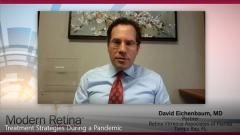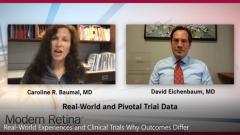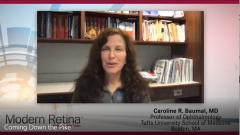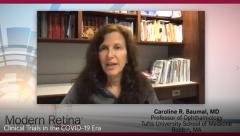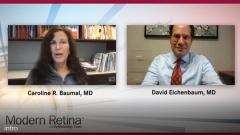
The Advent of the Anti-Vascular Endothelial Growth Factor (VEGF) Treatment Regimen
Episodes in this series

Caroline R. Baumal, MD: Let's start by talking about the impact the introduction of anti-VEGF has had on medical retina, what the mechanism of action of these intravitreal agents is, and what some of the innovations are that we've seen in medical retina as they pertain to neovascular AMD. Dr. Eichenbaum, would you like to begin?
David Eichenbaum, MD: I was fortunate enough to train with you at Tufts New England Eye Center and Ophthalmic Consultants of Boston during the real dawn of these anti-VEGF agents. I remember being a fellow from 2005 through 2007, and I didn't appreciate at the time how the entire field was changing in a way that we may never see as revolutionarily again in my practice lifetime.
I can now say 15 years later that I trained during an era of great innovation. The anti-angiogenic agents were a strike of gold. As you know and as I learned, they block vascular endothelial growth factor, they inhibit a single protein. They keep it from binding to one receptor that works with that family of proteins.
What's remarkable is that the clinical and scientific impact of that single inhibition changed the way that we treat and the prognosis that we have for common blinding retinal conditions of some heterogeneity — wet AMD, diabetic eye disease, retinal venous disease, myopic macular degeneration, or radiation retinopathy. It's remarkable how medical retina went from being a field that was kind of sad and prognoses weren't good to a field where we have happiness and success and safety, albeit with some significant burdens to treatment, some inconveniences to treatment, and some significant costs to treatment, both societally and financially when the patients have to come in frequently to enjoy these good results. But we’re doing much better for our patients than we did at the start of my fellowship.
Dr. Baumal: You hit the nail on the head. Anti-VEGFs have revolutionized how we treat our patients, and this goes hand-in-hand also with optical coherence tomography (OCT). That technology and that treatment have changed how we can do for our patients. The one thing that's amazing is that in the past before we had these treatments, we would often not see patients until very late in the disease, and there was very little we could do for patients, so we didn't bring them back in for follow-up.
How do you feel about photodynamic therapy (PDT) now? Do you think that there is a role for it in any of your patients?
Dr. Eichenbaum: That’s a great question. We do have a PDT machine, and I did learn PDT with you and the faculty at Tufts and Ophthalmic Consultants in Boston. I have looked at the EVEREST study, and do use it as primary therapy for polypoidal choroidal vasculopathy (PCV). I don’t use PDT as primary therapy in common wet macular degeneration. I do use it in in certain retinal angiomatous proliferation (RAP) lesions, to try to reduce injection frequency.
I'd say the utilization early on in the treatment landscape is rare, but not unheard of. I find those RAP lesions less commonly than maybe in other populations, and I've used it in polypoidal choroidal vasculopathy (PCV) lesions similar to the EVEREST population patients.
Of course, there is data for PDT treatment for central serous retinopathy. I think it works well for that, but there are access issues. I think reduced load PDT in a small percentage of select wet AMD patients probably reduces your overall objection burden despite the absence of populations in those studies being accessible to me, and the absence of consistency in those studies. I still use it in a very small sliver of my patients.
Dr. Baumal: I have patients in my practice from early 2000 who had PDT sometimes 7, 8, 9 times, multiple times. You could repeat it not infrequently, and I think overall it doesn't really get to the root of the issue as well as anti-VEGF therapy certainly. The studies show that while PDT helped with the initial exudative process patients eventually had vision loss, so I really do reserve it primarily for my non-neovascular AMD patients like the central serous chorioretinopathy patients and polypoidal patients, which we have quite a few at Tufts in Boston.
It is more of a bigger procedure to do PDT than it was in the past. People don't want to necessarily have the nurse, put the IV in or start the drug, so we end up doing a lot of PDT here for central serous chorioretinopathy. Those patients are sent to us, but I really have not used it much for neovascular AMD.
Let me ask you one more question. There are places where patients are just coming in, having an OCT, going home, and then being called back if they need an injection. Do you think that would fit into your treatment paradigm?
Dr. Eichenbaum: That's a great question, and I had this conversation casually just the other day. In my patient population, they would not like that. They do not want to come back twice. My patients want to come in and get treated, and we forget when we do that that they still have to have the driver bring them to the OCT. Then if you’ve got to do a shot, they’ve got to come back in a few days with the same driver.
They look at it as extra cost, extra time, extra hassle, and the conversation I was having is that half of the patients seem to like it and half of them are saying doctor, why am I coming back twice now for this stuff that you used to do with me and my son or me and my daughter or me and my caregiver in one visit? They truly don't like it. That hasn't worked, and that retina specialist has potentially lost patients because of that.
Newsletter
Keep your retina practice on the forefront—subscribe for expert analysis and emerging trends in retinal disease management.


